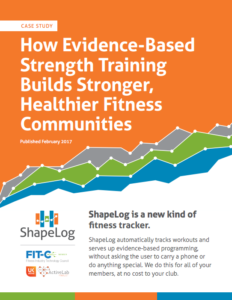Case Study: How Evidence-Based Strength Training Builds Stronger, Healthier Fitness Communities

The summary of results is below, but you can download the full report here: Case Study: Evidence-Based Strength Training
About This Report
We all know exercise is important, but few of us know what the heck we’re doing at the gym. For twelve weeks, ShapeLog tracked the workouts of fifty normal people, and used the data to help users improve their performance. What happened? Users got stronger and healthier. Engagement and membership grew. Users felt empowered to spend time in the weight room, which can be an intimidating place for most folks.
These results are repeatable at scale. The technology to help fifty million people is exactly the same that we used for this pilot. Soon we’ll all be able to stop guessing at the gym, and use evidence-based programming designed just for us.
A warning for non-geeks: this report gets very geeky. Since we all know data is only as useful as what you can do with it, our motivation for making it available here is to connect with others who see the potential in it.
Case Study Summary
Overview: ShapeLog engaged in a pilot that spanned four months at three medium-sized gym locations (250-750 members). Involvement included 30 women and 20 men who have collectively experienced more than 160 workouts. The average participant returned for more than 3 ShapeLog workouts and the maximum experienced by a single individual was 16. The participants voluntarily opted in to the engagement, which was formatted as a group strength training circuit class. Each circuit class was designed and administered by one of our three trainers. A subset of 15 individuals were selected for longer term tracking based on whether they met our minimum engagement threshold.
Circuit Format: The circuits were routinely changed according to the desires of the trainers, but always consisted of 6 – 10 weight machine stations (equipped with one of our patented sensors) and included “active rest” exercises (jumping jacks, lunges, etc.) performed during the breaks between the sets. Participants performed three 30-second sets at a single station then rotated to the next location. Given the variability in the number of stations, the results reported here are normalized by the station count so as to not favorably skew values from circuits that feature a greater number of machines.
Methodology: Each participant was trained in on the format for the circuit then shown a sample report illustrating the type of information being tracked. The reports emphasize work output (measured in milliwatt-hours, or mWh) which accounts for the amount of weight lifted and total distance travelled. It is also a unit that can be summed for all machine types in a scientifically valid manner. Emphasizing work output in the reports inherently encourages power training rather than strength training (i.e. leaning/toning rather than adding bulk) but also maximizes calorie expenditure in a fixed amount of time, therefore creating a well-rounded and efficient format. Alternative reporting formats and circuit designs pursued in parallel with this pilot accommodate strength training and optimize for maximum power (watts) and force (newtons).
Results: The full quantitative summary is available in the full report, but key takeaways are:
- All but one of the participants increased his/her work output capability
- The average participant increased his/her output by 98%
- Increase in output was proportional to the number of classes attended, with an average of 16% increase for each additional class taken
